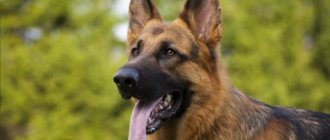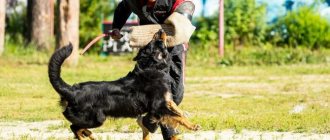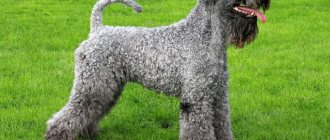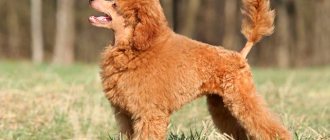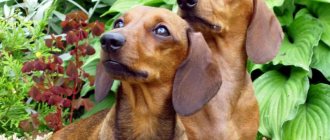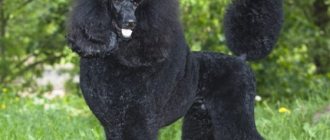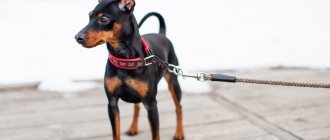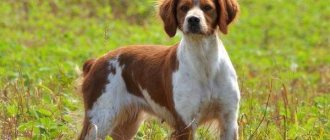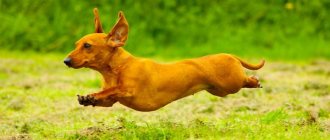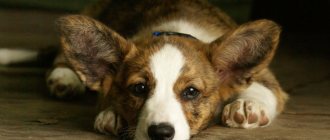Caucasian Shepherds are strong and robust dogs, distinguished by their strong character and good health.
Living in high mountains, long journeys to new pastures and fights with wolves made them resistant to cold and precipitation.
And also to many diseases.
But how long can a Caucasian Shepherd live and what needs to be done in order to prolong its life?
And how should you care for an aging pet of this breed?
Life expectancy of a standard Caucasian Shepherd dog in boys and girls
Caucasian Shepherds live on average 9-12 years . At the same time, the lifespan does not depend too much on the gender of the dog. Although, some females with age begin to suffer from serious pathologies of the reproductive system, which is why they live less than they could.
At the same time, male dogs can also suffer from diseases of the genitourinary organs, which reduce their life expectancy.
The lifespan of Caucasian Shepherds is not related to the gender of the animal.
It is much more strongly influenced by other factors, such as, for example, conditions of detention, care, illnesses suffered in youth.
The minimum lifespan of Caucasian Shepherds is 9 years, the average is 11, and the maximum lifespan of a pet of this breed is 15 years..
Expert opinion
Kozhevin Semyon Kirillovich
Expert dog handler.
“Under proper maintenance conditions, a Caucasian Shepherd can live 12-15 years. And what its life expectancy will be depends not least on how the owner treats the pet. If he takes care of the shepherd dog, tries to provide it with adequate nutrition and good care, such a dog has a much greater chance of becoming a long-liver than an animal that has spent its entire life in an enclosure or on a chain and eating low-quality food. Heredity also matters: Caucasian Shepherds from healthy lines live longer.”
How many live on the street, on chains and at home?
Caucasian Shepherds were originally bred to work in high altitude conditions, where sudden changes in temperature and precipitation are common..
The long, thick hair of these dogs provides them with a comfortable existence in cool and even cold temperatures, but they tolerate heat and stuffiness more difficult.
In a yard or enclosure, if there is a warm kennel and a canopy that protects from rain, snow and direct sunlight, a Caucasian Shepherd Dog can live 11-12 years, and, if lucky, even more.
Chain existence has a negative impact on the psyche and well-being of this intelligent and formidable animal and reduces its life expectancy . Such dogs usually live no more than 7 years.
If you keep a Caucasian Shepherd in a house or apartment, this also does not contribute to its longevity, since the dog will suffer from heat, stuffiness and low air humidity during the heating season.
Lack of exercise due to apartment living will also not have a very good effect on the pet’s well-being.
Caucasian Shepherd Dogs live 9-10 years in urban conditions.
Dogs of this breed live the longest in the courtyard of a private house or in an enclosure, provided that they are fully fed and cared for.
How to determine age?
The easiest way to determine a dog’s age is by the condition and color of its , as well as by its teeth and eyes :
- Teeth . By the age of 2.5 years, the middle incisors on the lower jaw begin to wear out, and the teeth themselves are no longer as snow-white and shiny as before. By the age of three, abrasions also appear on the upper hooks, and at 4 years - on the middle upper incisors. By the age of five, the fangs wear off and look dull. At the age of 6, teeth begin to turn yellow and tartar forms on them faster. Older animals may even begin to lose some of their teeth.
- Wool . With age, the coat becomes coarser and less shiny. At 6-7 years old, the first gray hair appears on the Caucasian Shepherd's face. Later it spreads to the entire face and forehead of the animal.
- Eyes . After the pet turns 7 years old, its eyes appear deeper set. Dilation of the pupil and clouding of the lens caused by senile ailments may occur.
Having noticed one or more of the signs of aging in a pet, the owner needs to reconsider its diet and living conditions..
Dog appearance (standards)
Photo: https://www.flickr.com/photos/ [email protected] /33585741838/
Dimensions
The minimum height of an adult male is 68 cm, females begin their height count at 64 cm. The weight of males starts at 50 kg, females cannot be lighter than 45 kg.
During the existence of the breed, some of its representatives reached a weight of 110 kg.
Wool
There are long-haired and short-haired Caucasians. The second variety is the most popular. The length of the coat of such breeds is at least 5 cm. It is straight, rather coarse and does not fit tightly to the body of the animal. There is undercoat.
Colors
The most popular and common colors are shades of gray, brown, red and brindle.
Head
The head, wide in the skull area, tapers towards the muzzle. Viewed from above, it can be compared to a blunt wedge.
Teeth and jaws
Healthy, white teeth. According to the standard, the cutters must fit snugly against each other. Both a straight bite and a scissor bite are acceptable.
Eyes
The Caucasian dog has small eyes. They are located widely and slightly obliquely. Their color ranges from dark brown to hazel.
Body and limbs
The chest is oval, the back is straight. The animal is powerful and muscular. The paws, front and rear, are massive, located parallel to each other.
Tail
The Caucasian tail is set high and has a crescent shape.
Rock defects
The following are considered defects:
- small head, disproportionate to the body;
- small teeth;
- light eye color;
- thin ears;
- hunched back;
- bobtail;
- soft or curly coat;
- very light weight;
- coarse or too light build;
- insecure behavior.
Main causes of premature death
- Heredity . Dogs of some lines live longer than representatives of others. In addition, hereditary diseases can also significantly reduce life expectancy.
- Infections . Transferred at an earlier age, they do not pass without leaving a trace on the pet’s body and greatly affect its life expectancy. For example, a disease such as hepatitis can negatively affect the condition of the liver, which may not be noticeable in young years, but will certainly affect it with age.
- Chronic diseases . If one of these ailments appeared in youth, then with a high degree of probability it will develop again in an older pet, and they are much more severe in older dogs than in younger years.
- Accidents . They can occur due to the fault or oversight of the owners, for example, if the owner left the gate open, and the dog ran out into the street and was hit by a car.
In order to prevent household poisoning, the owner of a Caucasian Shepherd dog needs to be careful and follow safety precautions when treating a house or garden against pests, as well as when working with paints, varnishes and other chemicals.
Historical reference
The distribution area of the breed is the territories adjacent to the Caucasus Range, as well as the steppe regions of southern Russia. The formation of the breed occurred not only as a result of natural selection, but also under the influence of the national traditions of the peoples of the Caucasus.
Historically, Caucasian Shepherd Dogs were used to protect herds and homes from predators and aggressors. The first mention of the use of large mastiff-like dogs by the troops of the Armenian king Tigran II dates back to the 1st century BC.
Selection work with the breed began in the USSR in the late 20s of the 20th century. In the process of selection, physical strength, confidence and fearlessness, acute hearing, good eyesight, and the presence of thick, impervious to precipitation, have always been cultivated as mandatory qualities.
All this, as well as the endurance and unpretentiousness of Caucasian Shepherd Dogs, make it possible to use them in various, including the most severe climatic conditions.
How to extend the life of a pet?
In order for a dog to live as long as possible, you need to take care of it from puppyhood: feed it properly, vaccinate it on time, give it sufficient, but not excessive, physical activity.
IMPORTANT!
It is very important to pay attention to the education and training of the Caucasian Shepherd, since a well-trained and obedient Caucasian Shepherd is less likely to become a victim of an accident than an untrained animal.
It is also necessary to approach issues of breeding use responsibly . A dog that does not have access to breeding should not be bred.
It is impossible to breed females every time they are in heat, since frequent pregnancies and childbirth exhaust the animal’s body and lead to early decrepitness.
It is also better not to breed a male dog if he does not have high show scores, since after the first mating the dog may begin to run after every female in heat, which may ultimately end in his death under the wheels of a car or in the forest from hunger and thirst.
From about 6 years of age, or even earlier, you need to start carrying out preventive medical examinations in the clinic, which will help identify the first pathologies in a seemingly healthy shepherd dog and cure them in time..
Proper nutrition
The Caucasian Shepherd is a large breed, and improper nutrition greatly affects the state of the musculoskeletal system of these dogs, which is why arthrosis and arthritis can develop in old age.
A pet of this breed needs high-quality food from early childhood..
The Caucasian Shepherd is fed either commercial food for large dogs, or its food is prepared separately.
You can feed your dog muscle meat, trimmings or offal, with the exception of lungs, kidneys and udders. Be sure to add porridge cooked in low-fat broth or water to the meat.
Vegetables, herbs, and lactic acid products should become an integral part of the Caucasian Shepherd's diet..
If your pet has an allergy or other disease, it should be switched to a special diet food.
Brief history of the breed
What is this dog like? It’s worth starting with the fact that it is not just large. She's huge. Height at the withers reaches 75 centimeters. This dog weighs about 80 kilograms. Although some males - representatives of the breed - can weigh up to 110 kilograms. Impressive dog, isn't he?
Along with its appearance, the Caucasian Shepherd Dog (a photo of the dogs is given below) has an equally impressive character. These dogs were brought out for protection. The Caucasus is a huge territory with its own traditions and foundations. Here, preference has always been given to cattle breeding and sheep breeding. People needed an unpretentious dog that could protect the herd from wolves and unkind people. The Caucasian Shepherd became such a dog. Its ancestor is the Tibetan Great Dane. Please do not confuse the old Tibetan Great Dane with the modern Tibetan Mastiff. They are different.
As a result, today there is a dog that is distrustful of strangers and is capable of fiercely protecting the territory and herds entrusted to it. Representatives of the breed gained wide popularity outside their homeland. In Russia they are used as guard and service dogs.
Quality maintenance and care
Caucasian Shepherds feel best in the yard of a private house or in an enclosure, but not on a chain. The animal should have a warm booth and the opportunity to hide in the shade of trees or under a canopy from the sun's rays.
Caring for your dog includes brushing 2 times a week, and during shedding - every day . Exhibition animals also need professional grooming.
It is recommended to wash Caucasian Shepherd dogs no more than 2-3 times a year using special detergents.
Eyes are rubbed as needed . Teeth are brushed approximately once every 2 weeks with a special paste and brush for animals. Ears, when dirty, are cleaned using cotton swabs.
Claws are trimmed as they grow . If there is a hard surface in the enclosure or yard, you will not have to do this too often.
Education and training
Raising a Caucasian Shepherd should begin from the first days of its appearance in the house. You should start training with simple things, and a smart dog will quickly understand all the requirements. The animal must be taught to go to the toilet in a strictly designated place, not to pick up food from the floor and not to take treats from the hands of strangers.
The baby needs to be made to understand that he should not chew things in the house and jump on the owner. Yes, it is clear that the puppy is happy to meet you and this action does not cause any difficulties. But this is just the beginning. Imagine that the pet will grow up and will also happily greet you. At best, his manifestations of joy can knock the owner off his feet.
You also need to start training dogs when the baby is still small, and do it throughout your life.
The owner must be a leader in the eyes of the dog, only then can one count on a successful outcome of the enterprise.
When training Caucasians, you should follow some recommendations.
- First of all, you can't yell at her. The Caucasian dog is a thinking person with high intellectual indicators and a balanced psyche. She just doesn't understand the screaming and may become embittered.
- Secondly, you should never hit a dog. At such moments, the animal completely switches off and ceases to understand its surroundings. If this action did take place on your part, you can be sure that the pet simply will not respond to this command for at least a month.
- Thirdly, the dog cannot be rushed. She will not blindly follow commands, but will carefully think and weigh everything. If the owner starts repeating the same command for a long time, it will lose all meaning for the animal and become just an ordinary set of words.
Be sure to praise your dog for every success. You can let the animal run. The pet must understand that as soon as he does everything correctly, he will definitely be praised and let go to play.
The Caucasian's rebelliousness, unpredictability and impetuosity reach their maximum by the age of one year. At this time, it is very difficult with the pet, as its rebellious spirit manifests itself in open disobedience. Don’t despair; the main thing at this moment is not to stop parenting. Be firm, even if you have to impose your will on the animal and force it to follow commands without letting it off the leash.
I would like to note that training a Caucasian Shepherd dog, guided only by articles on the Internet, is quite a risky business. If possible, it is worth taking a training course with a dog handler. Of course, a specialist will not do all the work for you, but he will at least guide and tell you what to do in this or that case.
Caring for an older dog
An older Caucasian Shepherd becomes less active: she sleeps longer and moves less . Her hearing or vision may deteriorate, and negative traits may appear or intensify in her character.
CAREFULLY!
It is strictly forbidden to walk an elderly pet without a leash, as it can easily become a victim of an accident.
Caring for an older Caucasian Shepherd remains the same as in its youth: timely cleaning of eyes, ears, teeth and trimming of nails.
In terms of veterinary care, in addition to regular dewormings and vaccinations, annual preventive examinations in the clinic are also added..
Older dogs are prone to colds, and they often have joint pain. This is why you need to additionally insulate the kennel in cold weather and make sure that the dog has soft and comfortable bedding.

